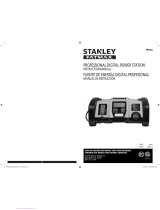
4
4
• This equipment employs parts (switches, relays, etc.) that produce arcs or sparks. Therefore, if used in
a garage or enclosed area, the unit MUST be placed not less than 18 inches above the floor.
• THIS UNIT IS NOT FOR USE BY CHILDREN AND SHOULD ONLY BE OPERATED BY ADULTS.
CAUTION: TO REDUCE THE RISK OF INJURY OR PROPERTY DAMAGE:
• NEVER ATTEMPT TO CHARGE A FROZEN BATTERY.
• Do not charge the battery while the engine is operating.
• Stay clear of fan blades, belts, pulleys, and other parts that can cause injury to persons.
• Vehicles that have on-board computerized systems may be damaged if vehicle battery is jump-started.
Before jump-starting, read the vehicle’s owner’s manual to confirm that external-starting assistance is
suitable.
• When working with lead acid batteries, always make sure immediate assistance is available in case of
accident or emergency.
• Always have protective eyewear when using this product: contact with battery acid may cause
blindness and/or severe burns. Be aware of first aid procedures in case of accidental contact with battery acid.
• Have plenty of fresh water and soap nearby in case battery acid contacts skin.
• If battery acid contacts skin or clothing, wash immediately with soap and water for at least 10 minutes
and get medical attention immediately.
• Never smoke or allow a spark or flame in vicinity of vehicle battery, engine or battery charger.
• Remove personal metal items such as rings, bracelets, necklaces and watches when working with a
lead acid battery. A lead acid battery can produce a short circuit current high enough to weld a ring, or
similar metal object, to skin causing a severe burn.
• Never allow battery acid to come in contact with this unit.
• Do not operate this unit in a closed area or restrict ventilation in any way.
• Always turn the battery charger off by unplugging it when not in use.
• Operate battery charger only as described in this Instruction Manual.
• Check battery charger and components periodically for wear and tear. Return to manufacturer for
placement of worn or defective parts immediately
SPECIFIC SAFETY INSTRUCTIONS FOR LITHIUM BATTERIES
12V Lithium charge mode is designed for 12-volt lithium-ion batteries only, including iron phosphate.
WARNING: Use this mode with extreme care. This mode should only be used with 12V Lithium-ion
batteries that have a built-in battery management system (BMS). Lithium-ion batteries are made and
constructed in different ways and some may or may not contain a battery management system (BMS).
Consult the Lithium-ion battery manufactures before charging and ask for recommended charging rates
and voltages. Some Lithium-ion batteries may be unstable and unsuitable for charging.
WARNING: – To reduce the risk of fire, electric shock, burst hazard, or injury to persons or property:
• Lithium batteries must be used and charged properly. Improper use can result in serious injury, fire, or
death.
• Lithium-ion batteries can explode in the presence of a source of ignition. Do not use lithium battery in
the presence of an open flame.
• Do not place this lithium-ion battery unit in fire or apply heat to it.
• Do not subject lithium battery to strong impacts or shocks. Or it may cause the battery to generate
heat, rupture or ignite.
• Do not expose lithium battery to water or salt water, or allow the battery to get wet.
• Avoid storing lithium battery in the basement, bathroom or other areas of the house that are or may
become wet or humid or where moisture may concentrate.
• Do not leave lithium battery in direct sunlight, or use or store it inside cars in hot weather. Doing so
may cause the battery to generate heat, rupture, or ignite.
• Never charge lithium battery near heat or flammable objects.
WARNING: NEVER THROW WATER ON A BURNING LITHIUM BATTERY! If a lithium battery does
catch on fire, it will burn even more violently if it comes in contact with water or even moisture in the
air. A fire extinguisher must be used.
PREPARING TO CHARGE A LEAD-ACID BATTERY
1. Be sure area around battery is well ventilated while battery is being charged.
2. Remove battery completely from boat/airplane or any confined area before charging.
3. If it is necessary to remove battery from vehicle to charge, or to clean terminals, always remove
grounded terminal from battery first. Make sure all accessories in the vehicle are off, so as not to
cause an arc.
4. Clean battery terminals, taking care to avoid getting corrosive material in eyes.
























